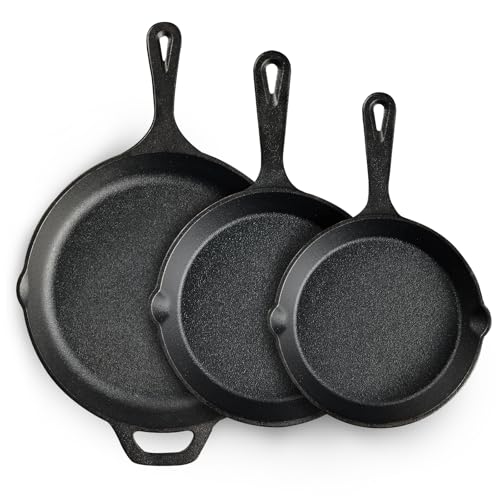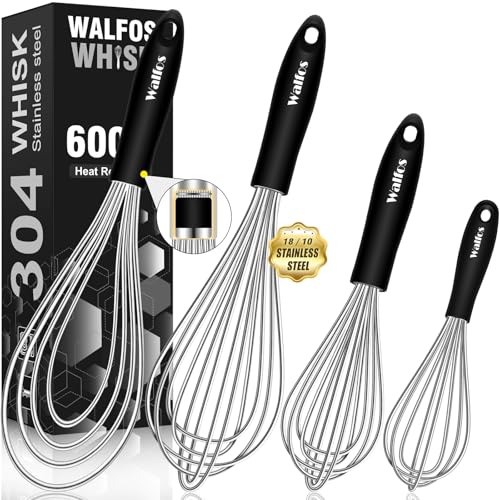We’ve all fallen in love with that glossy, savory-sweet sauce that makes Mongolian beef irresistible at our favorite Chinese restaurants. Even though its name, this beloved dish isn’t actually from Mongolia – it’s a Chinese-American creation that’s become a takeout staple across the country. The magic lies entirely in that rich, umami-packed sauce that transforms simple beef and scallions into something extraordinary.
What makes this sauce so addictive? It’s the perfect balance of soy sauce depth, brown sugar sweetness, and aromatic garlic and ginger that creates layers of flavor in every bite. The sauce clings beautifully to tender beef strips while maintaining that signature glossy finish we all crave.
We’re sharing our foolproof Mongolian beef sauce recipe that rivals any restaurant version. With just a handful of pantry staples, you’ll create a sauce that’s bold, balanced, and absolutely delicious. Once you master this recipe, you’ll never need to order takeout again.
What Is Mongolian Beef Sauce
Mongolian beef sauce forms the heart of this beloved Chinese-American dish. We consider it a glossy brown coating that transforms simple beef strips into restaurant-quality perfection. The sauce delivers a perfect balance of sweet and savory flavors that clings beautifully to meat and vegetables.
Soy sauce provides the umami foundation while brown sugar adds caramelized sweetness. Fresh garlic and ginger contribute aromatic depth that makes this sauce irresistible. We find that rice wine or dry sherry enhances the complexity with subtle fermented notes.
The sauce achieves its signature glossy appearance through cornstarch slurry. This thickening agent creates the perfect consistency that coats ingredients without becoming too heavy. We appreciate how the sauce maintains its shine even after cooling.
Traditional versions often include oyster sauce for additional richness. Some recipes incorporate hoisin sauce for extra sweetness and complexity. We notice that sesame oil adds a nutty finish that rounds out the flavor profile beautifully.
The consistency should coat the back of a spoon when properly prepared. We aim for a sauce that flows smoothly but isn’t too thin or watery. The color ranges from deep amber to rich mahogany depending on the soy sauce type used.
Restaurant versions typically achieve their distinctive flavor through high-heat cooking techniques. We replicate this at home by ensuring our wok or pan reaches the proper temperature before adding ingredients. The sauce caramelizes slightly during cooking which intensifies its sweetness and creates those signature crispy edges on the beef.
Essential Equipment and Tools
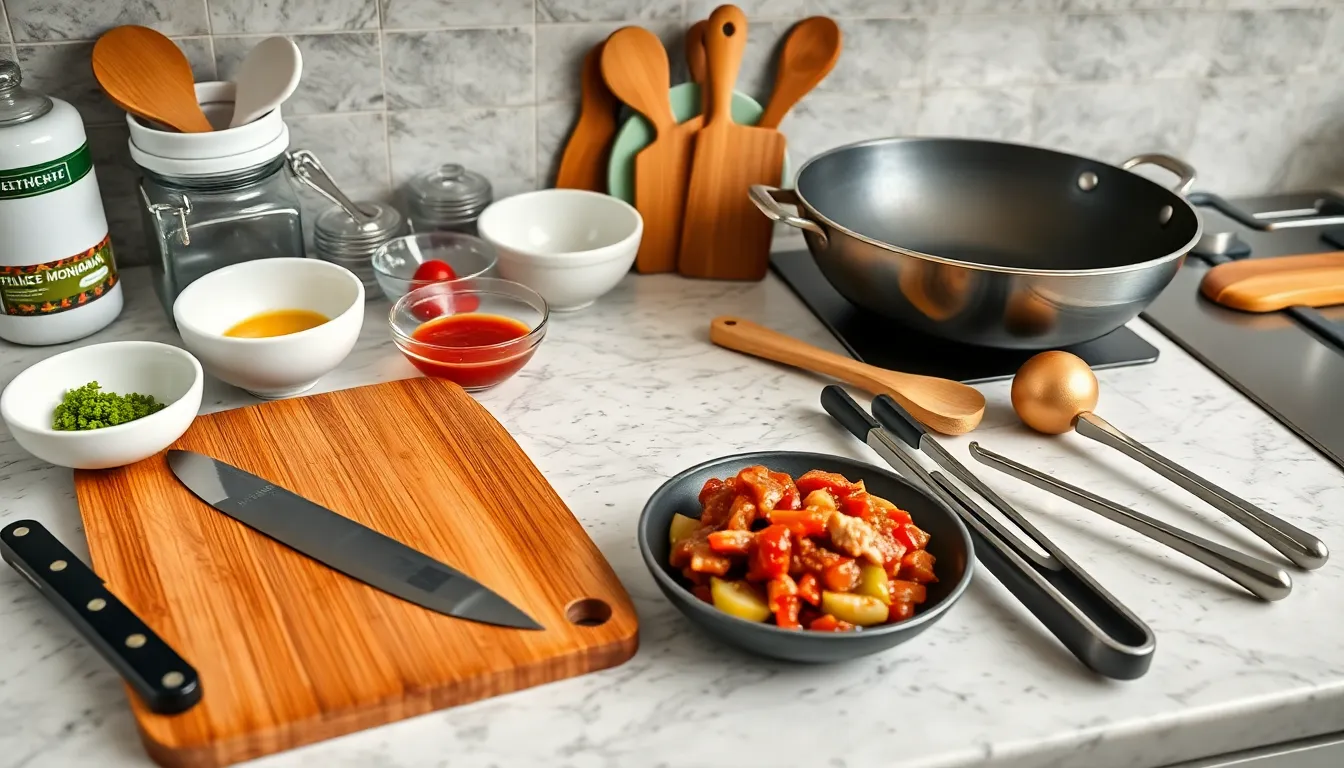
Creating restaurant-quality Mongolian beef sauce requires exact equipment that helps us achieve the perfect balance of flavors and textures. We recommend gathering these essential tools before starting your cooking process to ensure smooth preparation and optimal results.
Sharp Knife and Cutting Board form the foundation of our equipment list. Slicing beef against the grain requires precision to achieve tender results that absorb the sauce effectively. A quality cutting board provides stability during this crucial preparation step.
Mixing Bowls serve multiple purposes in our Mongolian beef sauce preparation. We use separate bowls for marinating the beef and combining sauce ingredients before cooking. Having various sizes available streamlines the cooking process significantly.
Measuring Cups and Spoons ensure accuracy when portioning soy sauce, brown sugar, water, and cornstarch. Precise measurements create consistent results every time we prepare this sauce at home.
Saucepan or Small Pot becomes essential for cooking and thickening our sauce mixture. The vessel should conduct heat evenly to prevent burning while allowing proper sugar dissolution and cornstarch integration.
Wok or Large Skillet stands as the most critical piece of equipment for authentic results. High heat tolerance and even heat distribution make woks superior for quickly searing beef and stir-frying aromatics like garlic and ginger. The curved surface promotes proper ingredient movement during cooking.
Tongs or Spatula provide control when turning beef slices and stirring sauce components. These tools prevent overcooking while ensuring even coating of all ingredients.
Whisk creates smooth cornstarch slurry integration without lumps. This tool eliminates clumping that could compromise our sauce’s glossy finish.
Plate or Tray holds cooked beef temporarily when working in batches. This prevents overcrowding in the cooking vessel while maintaining proper cooking temperatures.
Optional Tools include a garlic press or microplane grater for processing fresh garlic and ginger. These additions can enhance flavor extraction from aromatic ingredients.
| Equipment Category | Essential Items | Purpose |
|---|---|---|
| Cutting Tools | Sharp knife, cutting board | Beef preparation and slicing |
| Cooking Vessels | Wok/skillet, saucepan | High-heat cooking and sauce preparation |
| Mixing Tools | Bowls, whisk, tongs | Ingredient combination and manipulation |
| Measuring Tools | Cups, spoons | Accurate ingredient portioning |
| Serving Tools | Plate/tray | Temporary holding during batch cooking |
Ingredients
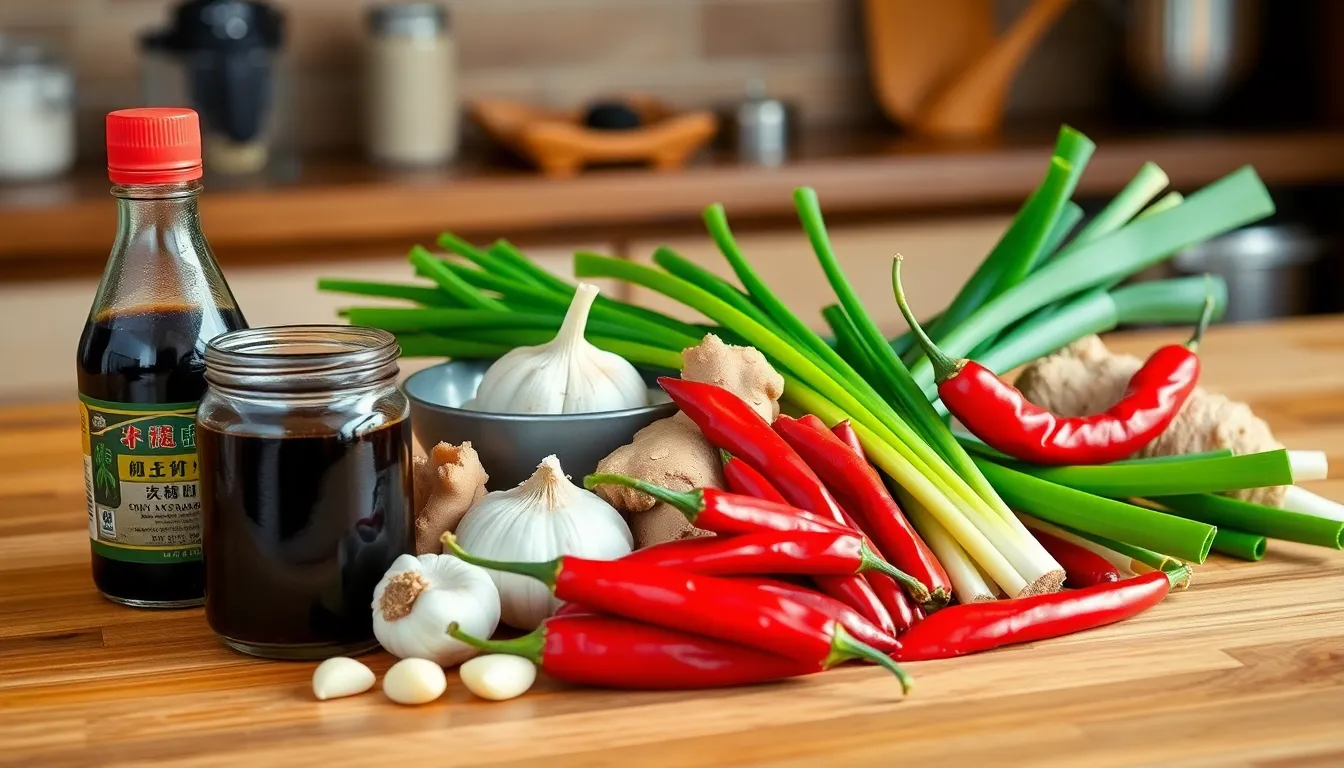
This Mongolian beef sauce recipe requires three distinct ingredient categories to achieve the perfect balance of flavors and texture. We’ve organized each component by its exact function to help you create a restaurant-quality sauce at home.
For the Sauce Base
- 1/4 to 1/3 cup soy sauce (light soy sauce preferred)
- 3 tablespoons brown sugar (light or dark, packed)
- 1 tablespoon oyster sauce
- 2-3 garlic cloves (minced or finely chopped)
- 1/2 inch fresh ginger (minced) or 1 teaspoon ground ginger
- 3/4 cup hot water or broth (chicken or beef stock)
- 2 tablespoons rice wine or Shaoxing wine (optional)
- 1 teaspoon Asian sweet chili sauce or red chili flakes (optional)
- 1/2 teaspoon Worcestershire sauce (optional)
For Thickening and Flavor Enhancement
- 1 tablespoon cornstarch
- 2 tablespoons cold water (for cornstarch slurry)
- 2-3 tablespoons neutral oil (vegetable, canola, or avocado oil)
Optional Garnish Ingredients
- 2-3 scallions (green parts only, sliced)
- 1/2 teaspoon red chili flakes or 1 fresh red chili pepper (sliced)
- 1/4 teaspoon white or black pepper
- 1 teaspoon sesame oil (for finishing aroma)
Instructions
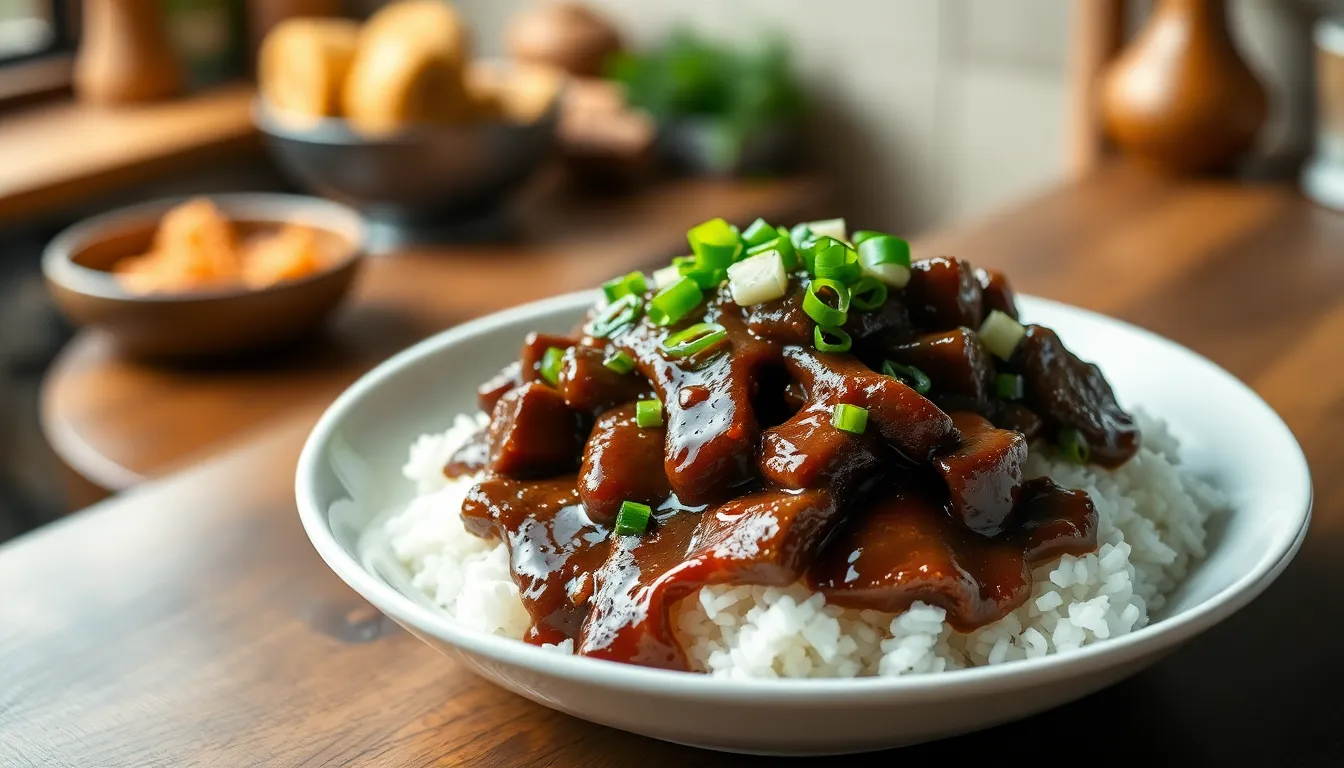
Creating our restaurant-quality Mongolian beef sauce requires careful preparation and timing. We’ll guide you through each essential step to achieve that perfect balance of sweet and savory flavors.
Prep the Ingredients
We start by slicing 1 to 1.5 pounds of flank steak into thin ¼-inch strips against the grain. This cutting technique ensures tender pieces that cook evenly and absorb our sauce beautifully.
Next we mince 3-4 fresh garlic cloves and prepare about 1 teaspoon of fresh ginger. The aromatic foundation these ingredients provide cannot be replicated with dried alternatives.
We slice our green onions for garnish and set them aside. Fresh scallions add color and a mild onion bite that complements the rich sauce perfectly.
Our sauce components need measuring: ½ cup soy sauce (light or low sodium works best), ½ cup packed brown sugar, ¼ cup water, and any optional ingredients like oyster sauce or tamari for enhanced umami depth.
Finally we toss our sliced beef in ¼ cup cornstarch until each piece is evenly coated. This coating creates the crispy texture we love while simultaneously helping thicken our sauce during cooking.
Make the Sauce Base
We heat vegetable oil in our skillet over medium-low heat before adding the minced garlic and ginger. The aromatics need about 1 minute to become fragrant without burning.
Our soy sauce, brown sugar, and water go into the pan next. We stir continuously to dissolve the sugar completely and prevent any grittiness in our finished sauce.
The mixture comes to a boil before we reduce heat to maintain a gentle simmer. We let this cook for 3-5 minutes until the sauce begins to thicken slightly and develops that characteristic glossy appearance.
Optional ingredients like oyster sauce or tamari can be incorporated at this stage. These additions provide extra umami complexity that elevates our sauce beyond basic sweet and salty flavors.
Add Thickening Agents
Our cornstarch-coated beef serves a dual purpose in this recipe. We cook the beef separately in batches until the edges turn golden brown, approximately 1-2 minutes per side.
The residual cornstarch on our beef pieces acts as a natural thickening agent when we add the meat back to our simmering sauce. This technique eliminates the need for additional cornstarch slurries in most cases.
We return our browned beef to the sauce and let everything simmer together. The cornstarch coating releases gradually and creates that signature glossy consistency that coats each piece of meat perfectly.
Final Seasoning Adjustments
We stir in our sliced green onions just before serving to maintain their bright color and fresh crunch. These shouldn’t cook long or they’ll lose their appealing texture.
Taste testing allows us to fine-tune our sauce balance. We can add more soy sauce for saltiness or additional brown sugar if we prefer more sweetness.
A pinch of red pepper flakes provides subtle heat for those who enjoy a little spice. We add these sparingly since the goal is enhancement, not overwhelming heat.
Our finished Mongolian beef sauce should coat the back of a spoon and cling beautifully to each piece of meat. We serve this immediately over steamed white rice while the sauce maintains its optimal temperature and consistency.
How to Use Mongolian Beef Sauce
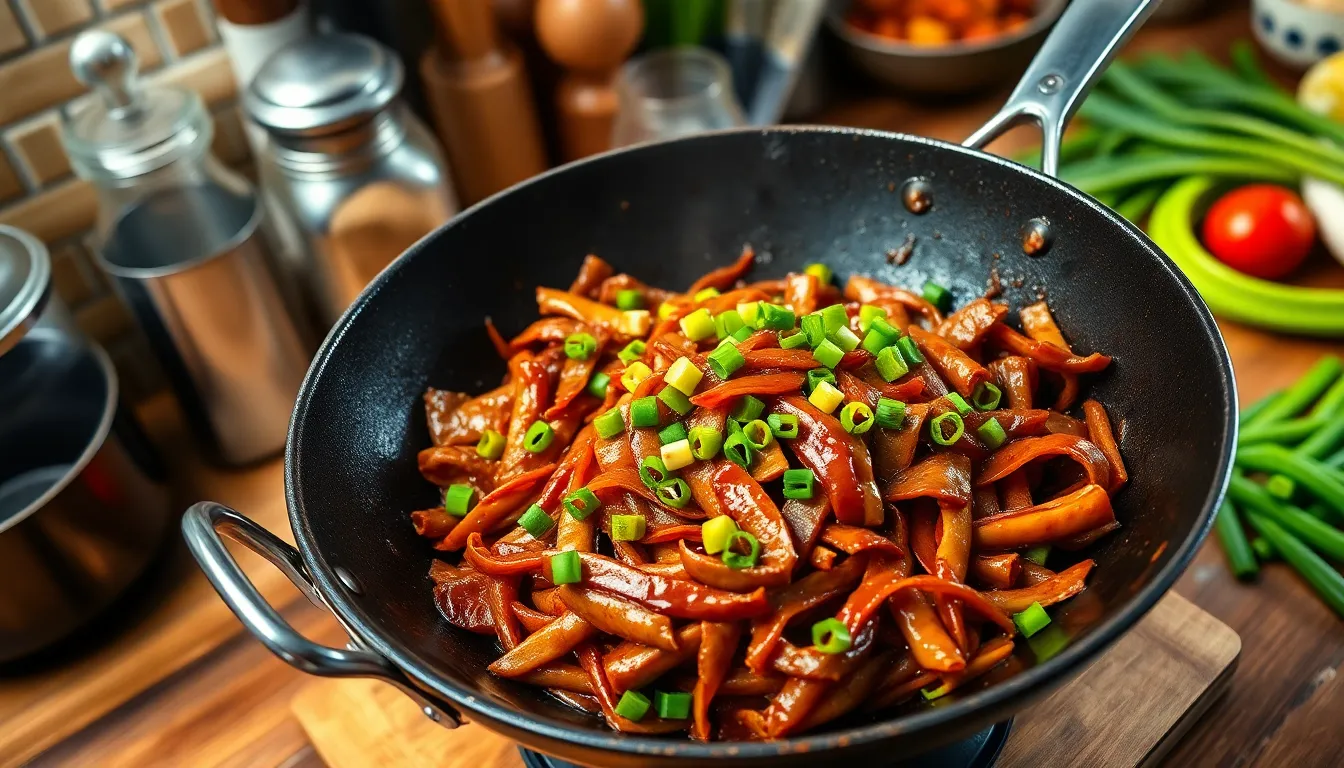
Now that you’ve mastered our signature sauce recipe, let’s explore the versatile ways to transform this glossy brown creation into restaurant-quality dishes. Our Mongolian beef sauce adapts beautifully to various proteins and cooking methods.
With Beef Stir-Fry
We start by selecting the right cut of beef for optimal results. Flank steak or New York steak works best when sliced thinly against the grain. Marinate these beef strips in soy sauce and cornstarch for 15-30 minutes before cooking. This combination tenderizes the meat while creating a protective coating that locks in moisture.
Heat your wok or large skillet over high heat until smoking hot. We cook the marinated beef in small batches to avoid overcrowding. Stir-fry each batch for 2-3 minutes until the edges develop a beautiful caramelized crust but the center remains slightly pink.
Remove the beef from the pan and set aside. Pour our prepared Mongolian sauce into the same hot wok to deglaze any flavorful bits. The sauce should bubble vigorously and begin to thicken within 30-60 seconds. Return the beef to the pan and toss quickly to coat every piece with the glossy sauce.
Finish by stirring in fresh green onions during the final 30 seconds of cooking. The residual heat wilts the scallions perfectly while maintaining their bright color and crisp texture.
With Other Proteins
Our versatile sauce transforms chicken, pork, and even firm tofu into satisfying meals. We prepare chicken thighs or breasts by cutting them into bite-sized pieces and coating lightly with cornstarch. The same marinating technique used for beef works wonderfully with poultry.
Pork tenderloin or shoulder offers another excellent protein option. Slice the pork into thin strips and follow the identical stir-fry process. The rich, sweet-savory profile of our sauce complements pork’s natural flavors exceptionally well.
Plant-based cooks can substitute extra-firm tofu for animal proteins. Press the tofu to remove excess moisture, then cube and coat with cornstarch before pan-frying until golden. The sauce adheres beautifully to the crispy tofu exterior while the inside remains silky smooth.
As a Marinade
Transform our sauce into a powerful marinade by combining soy sauce, brown sugar, minced garlic, fresh ginger, and rice wine in equal proportions. This concentrated mixture penetrates protein fibers to deliver deep flavor throughout.
Marinate beef strips for 1-2 hours in the refrigerator for optimal flavor infusion. Longer marinating times can break down the meat’s texture, so we recommend staying within this timeframe. The acids and enzymes in the marinade naturally tenderize tougher cuts while infusing them with aromatic complexity.
Reserve a portion of fresh sauce for coating during the final cooking stage. Never use marinade that has contacted raw meat as your finishing sauce. This dual-sauce approach ensures food safety while maximizing flavor impact in your finished dish.
Storage and Make-Ahead Tips
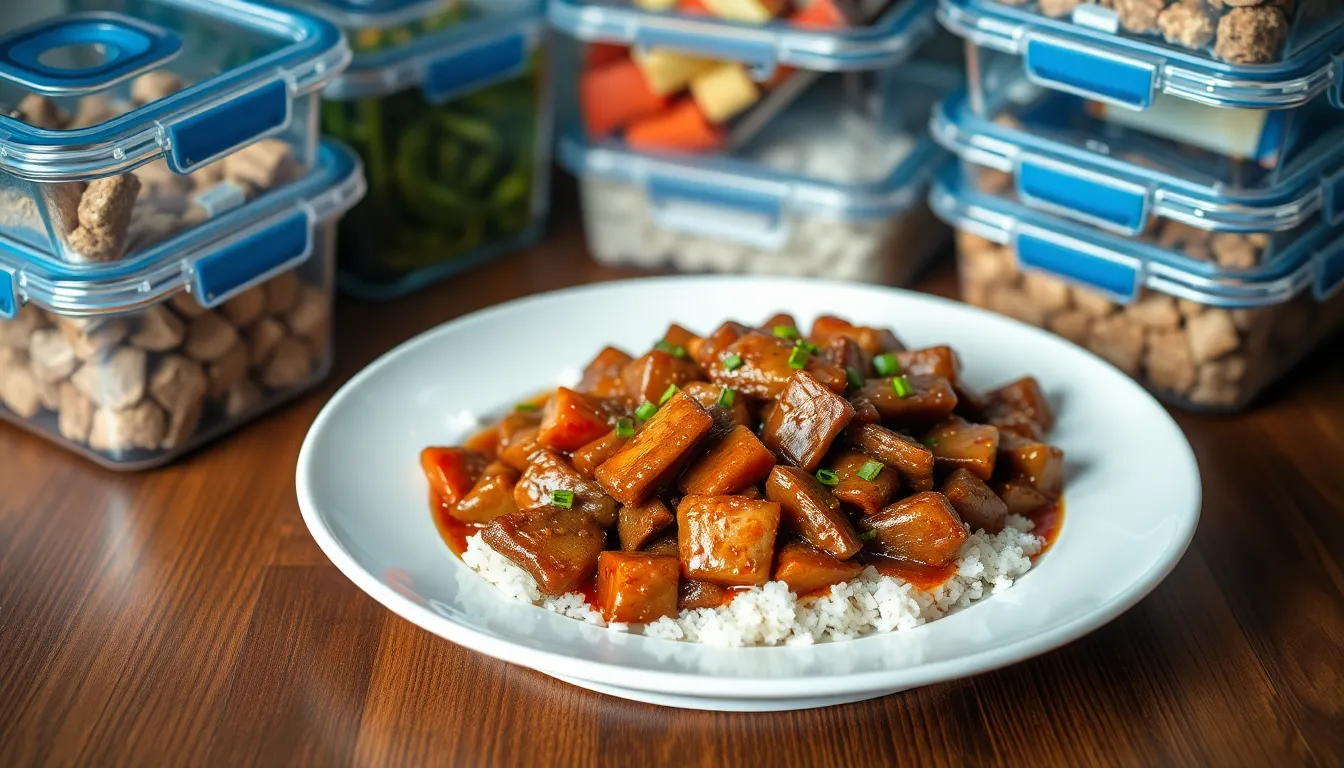
Our homemade Mongolian beef sauce keeps beautifully when stored properly. We can maximize the sauce’s freshness and flavor by following these proven storage methods.
Refrigerator Storage
We store our cooked Mongolian beef in an airtight container in the refrigerator where it stays fresh for up to 3 to 4 days. The sauce maintains its rich flavor and glossy texture throughout this period when properly sealed. Glass containers work exceptionally well for refrigerator storage as they don’t absorb flavors or odors.
Freezer Storage
Our Mongolian beef freezes remarkably well for up to 3 to 4 months when kept in airtight containers or freezer bags. We recommend dividing the dish into single portions before freezing for convenient meal planning and easy reheating. Always allow the dish to cool completely before transferring to the freezer to maintain optimal quality and prevent ice crystal formation. Remove any bell peppers or similar vegetables before freezing since they become mushy when thawed and reheated.
Reheating Instructions
We achieve the best results by reheating our leftover Mongolian beef in a skillet over medium heat to preserve the meat’s tenderness and the sauce’s perfect texture. Microwaving should be avoided when possible as it can make the beef rubbery and compromise the dish’s quality. Frozen portions require overnight thawing in the refrigerator before reheating in a skillet or oven for optimal results. Microwave reheating remains an option for convenience though it produces less ideal texture compared to stovetop methods.
Recipe Variations
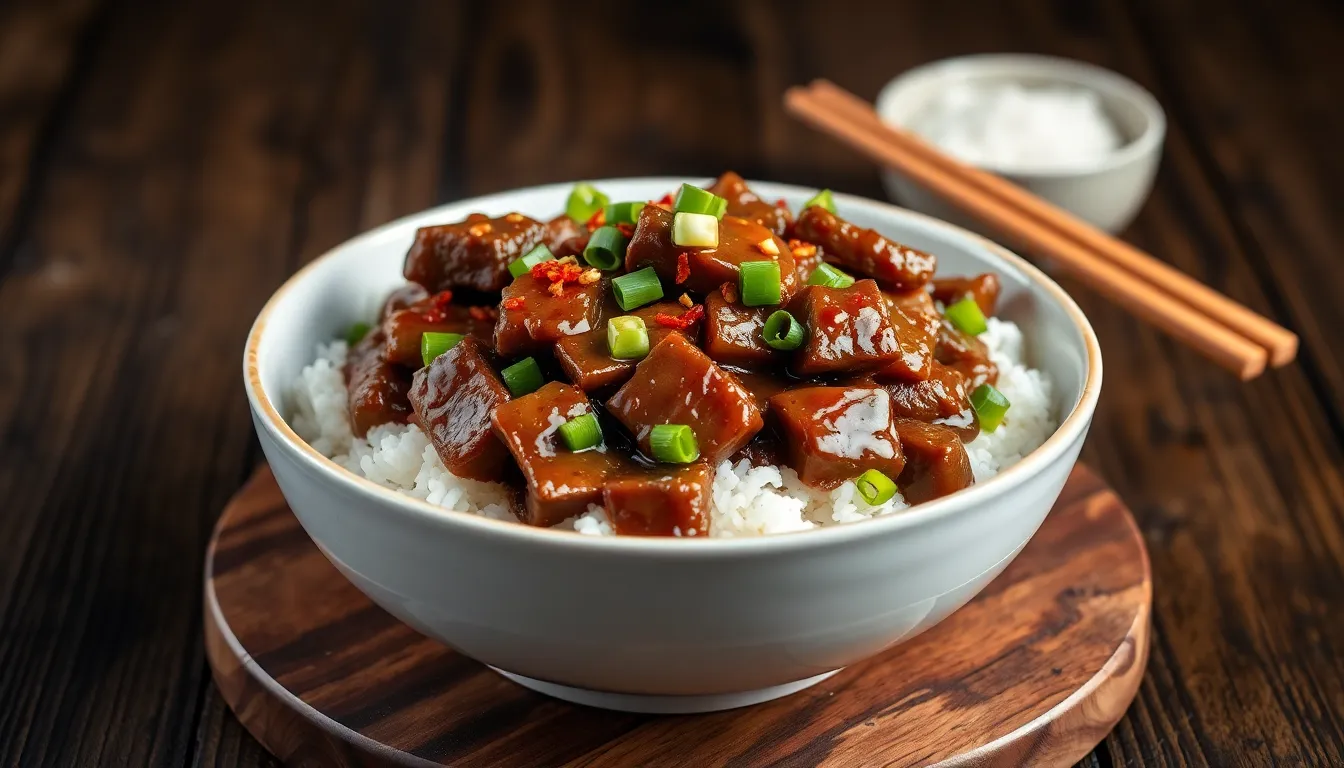
We can customize our Mongolian beef sauce to accommodate different dietary preferences and spice levels. These variations maintain the essential sweet and savory balance while addressing exact needs.
Spicy Mongolian Sauce
We elevate the heat level by incorporating chili sauce or red pepper flakes directly into our sauce base. Adding 1-2 teaspoons of chili sauce during the sauce preparation creates a balanced kick without overwhelming the sweet and savory profile. For those who prefer dried heat, we sprinkle 1/2 teaspoon of red pepper flakes into the hot oil before adding garlic and ginger. This technique allows the spices to bloom and infuse throughout the entire dish.
We can also garnish the finished dish with additional chili flakes for guests who want to control their spice level. The key is building heat gradually while preserving the signature glossy texture and caramelized sweetness that makes Mongolian beef sauce so appealing.
Low-Sodium Version
We reduce sodium content by replacing regular soy sauce with low-sodium alternatives and adjusting liquid ratios accordingly. Using 3 tablespoons of low-sodium soy sauce instead of the standard amount cuts sodium by approximately 40% while maintaining the essential umami flavor. We compensate for the reduced saltiness by adding an extra tablespoon of chicken or beef broth to maintain the sauce volume.
Omitting or reducing oyster sauce further decreases sodium levels without sacrificing depth. We enhance flavor complexity by increasing fresh ginger and garlic quantities slightly, allowing these aromatic ingredients to carry more of the flavor burden. This modification creates a healthier version that still delivers restaurant-quality taste.
Gluten-Free Alternative
We substitute regular soy sauce with tamari to create a completely gluten-free version of our Mongolian beef sauce. Tamari provides the same rich, salty flavor profile as traditional soy sauce while being naturally gluten-free. Using 1/4 cup of tamari maintains the authentic taste without compromising dietary restrictions.
We ensure all additional ingredients are gluten-free, including any broth or wine used in the recipe. Cornstarch serves as our thickener, which is naturally gluten-free and already standard in traditional Mongolian beef preparations. This variation proves that dietary restrictions don’t require flavor sacrifices when we make thoughtful ingredient substitutions.
Pro Tips for Perfect Mongolian Beef Sauce
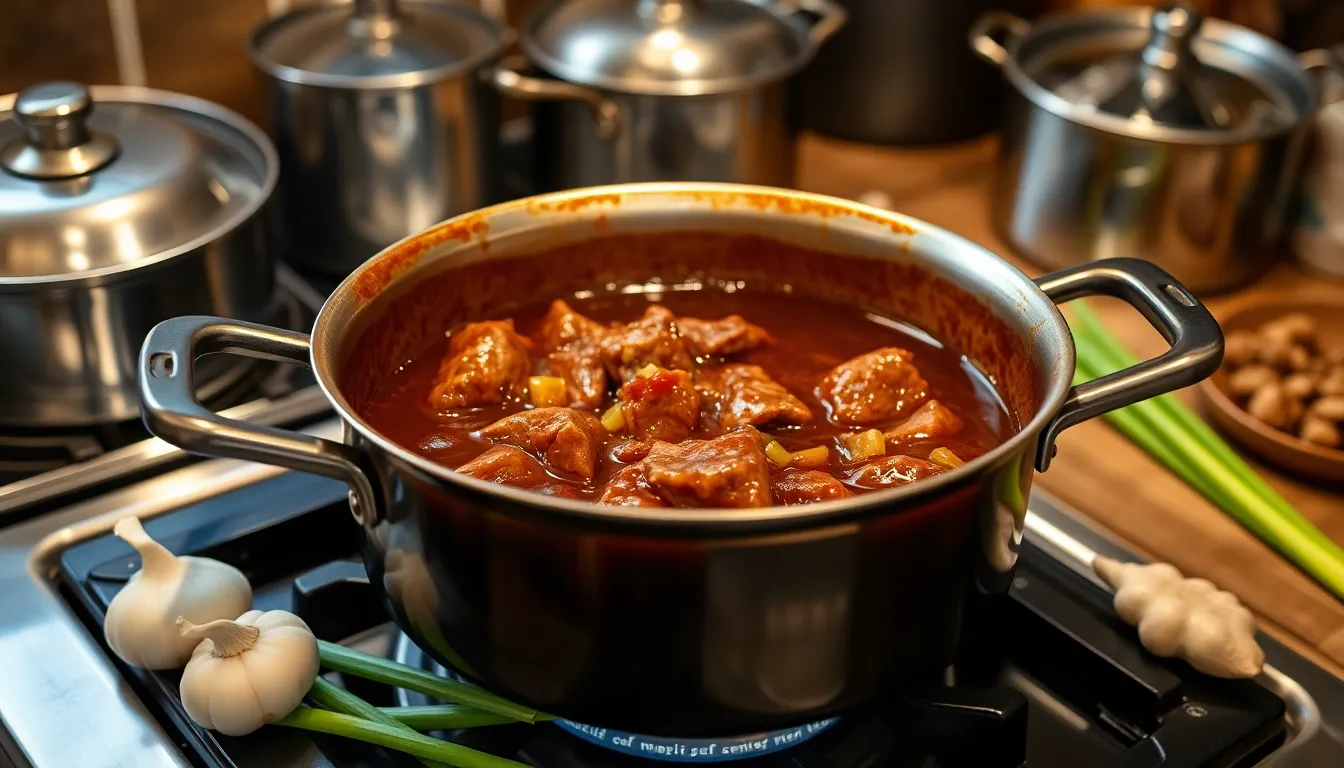
Balance Your Sweet and Savory Elements
We recommend starting with the foundation of flavor balance when crafting your Mongolian beef sauce. The key lies in adjusting brown sugar and soy sauce proportions to achieve that perfect sweet and savory harmony. Too much sugar overpowers the umami depth while excessive soy sauce creates an unpleasantly salty finish. Start with our recommended ratios and taste as you go.
Use Fresh Aromatics for Maximum Impact
Fresh garlic and ginger elevate your sauce dramatically compared to powdered or pre-minced alternatives. We always mince these ingredients just before cooking to preserve their volatile oils and pungent flavors. The difference in aroma and taste becomes immediately apparent when you use freshly prepared aromatics.
Master the Art of Caramelization
Allow your brown sugar to caramelize slightly during the cooking process for deeper flavor complexity. This technique adds subtle notes that distinguish homemade sauce from store-bought versions. Watch for the sugar to develop a rich amber color before adding other liquid ingredients.
Achieve the Perfect Sauce Consistency
Your sauce should cling beautifully to beef without being too thick or thin. We achieve this by simmering the mixture until it reaches the right consistency or adding a cornstarch slurry when needed. The sauce should coat the back of a spoon and create that signature glossy appearance.
Prepare Your Beef Properly
Marinating beef with soy sauce, Shaoxing wine, cornstarch, and baking soda ensures optimal tenderness and sauce adhesion. This preparation step allows the flavors to penetrate the meat while the cornstarch creates a coating that helps the sauce cling properly.
Control Your Cooking Temperature
High heat cooking with neutral oil creates the perfect sear on your beef before adding the sauce. We ensure our pan reaches the proper temperature to achieve that restaurant-quality texture and flavor development. The initial sear locks in juices while creating appealing caramelized edges.
Enhance with Optional Ingredients
Consider incorporating oyster sauce for additional umami richness or a touch of chili sauce for heat according to your preferences. These optional enhancements allow you to customize the sauce while maintaining its essential character.
| Ingredient | Purpose | Amount |
|---|---|---|
| Light brown sugar | Sweetness base | 1/4 cup |
| Hot water/stock | Liquid foundation | 3/4 cup |
| Light soy sauce | Umami and saltiness | 1/4 cup |
| Dark soy sauce | Color and depth | 1 teaspoon |
| Fresh garlic | Aromatic foundation | 2-3 cloves |
| Fresh ginger | Spicy warmth | 1 teaspoon |
Troubleshooting Common Issues
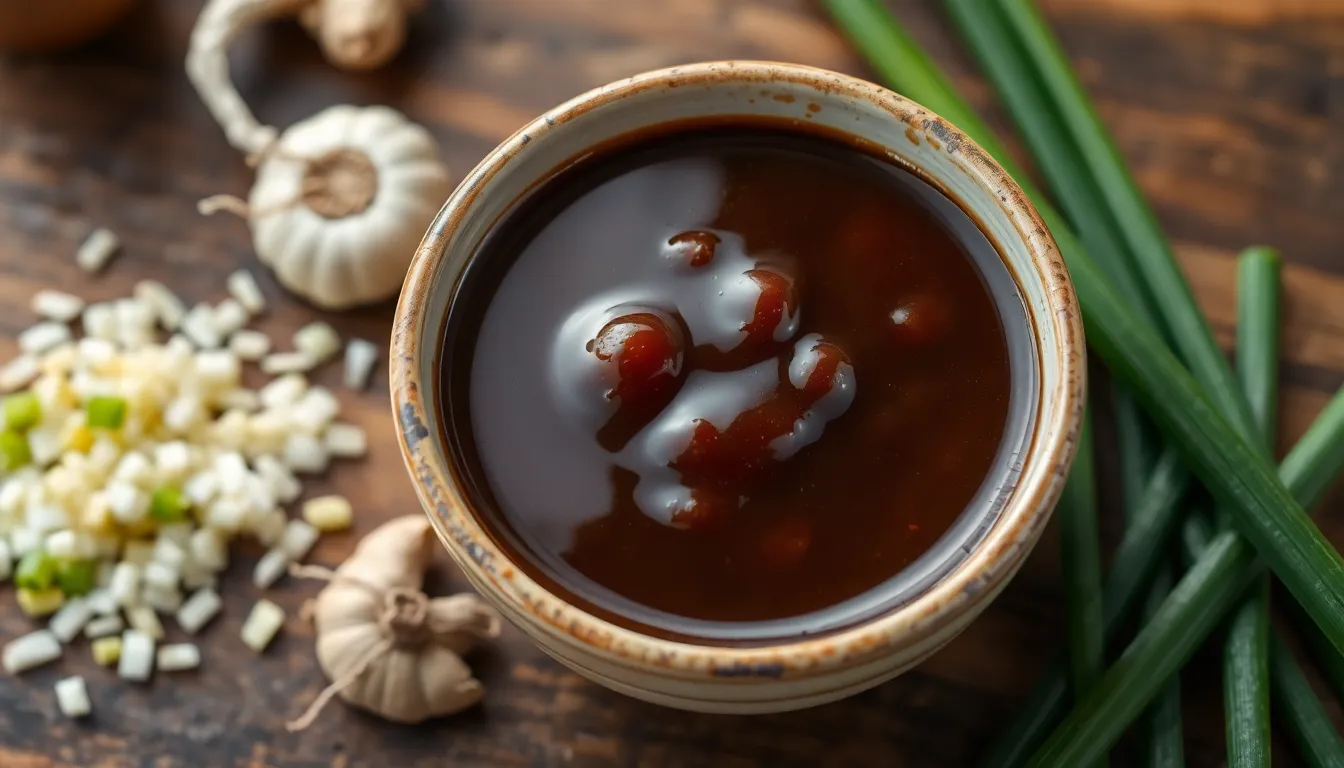
Even experienced home cooks encounter challenges when preparing Mongolian beef sauce. We’ve compiled the most common problems and their answers to help you achieve restaurant-quality results every time.
Sauce Consistency Problems
Sauce too thin: Add more cornstarch slurry gradually while stirring constantly. Mix 1 tablespoon cornstarch with 2 tablespoons cold water and slowly incorporate it into your simmering sauce. Increase heat slightly to activate the thickening properties and simmer until the sauce coats the back of a spoon.
Sauce too thick or gloopy: Thin out your sauce by adding small amounts of water or low-sodium chicken broth. Start with 1 tablespoon at a time and reheat gently while stirring. The sauce should flow smoothly and coat your beef without being overly viscous.
Lumpy sauce: Prevent lumps by always mixing cornstarch with cold water before adding to hot sauce. Strain your sauce through a fine-mesh sieve if lumps have already formed and return it to the pan to reheat.
Flavor Balance Issues
Overly salty sauce: Use low-sodium soy sauce as your base and taste as you go. If your sauce is already too salty, dilute it with unsalted water or broth and add a pinch of brown sugar to restore balance.
Lack of flavor depth: Fresh minced garlic and ginger make a important difference compared to dried alternatives. Add oyster sauce or tamari for enhanced umami richness. Consider incorporating a splash of Shaoxing wine for authentic restaurant flavor.
Burning or bitter taste: Monitor your cooking temperature carefully to prevent burning the brown sugar, which creates unpleasant bitter notes. Keep heat at medium when caramelizing sugar and stir frequently.
Beef Preparation Problems
Dry beef after marinating: Ensure your beef is properly marinated with sufficient liquid components including soy sauce, oil, and water. Add cornstarch to your marinade to help retain moisture during the high-heat cooking process.
Tough beef texture: Slice your beef against the grain and marinate with baking soda for 15 minutes before cooking. This technique tenderizes the meat fibers and creates the signature restaurant texture.
Beef overcooking: Cook beef in small batches over high heat to achieve crispy edges without overcooking the interior. Remove beef from heat as soon as it changes color to prevent toughening.
Temperature and Timing Issues
Sauce not adhering to beef: Your pan may not be hot enough or your sauce may be too thin. Increase heat and ensure your sauce has the proper consistency before combining with beef. The sauce should cling to each piece of meat when properly prepared.
Sauce separating: This occurs when the temperature is too high or when ingredients are added too quickly. Remove from heat immediately and whisk vigorously to re-emulsify. Lower the temperature before continuing to cook.
Conclusion
We’ve equipped you with everything needed to create restaurant-quality Mongolian beef sauce right in your own kitchen. From understanding the perfect balance of sweet and savory flavors to mastering the cooking techniques that make all the difference.
This versatile sauce recipe opens up countless possibilities beyond traditional beef dishes. You can experiment with different proteins store it for future meals and customize the flavors to match your preferences.
The key to success lies in using fresh ingredients maintaining proper cooking temperatures and achieving that signature glossy consistency. With our pro tips and troubleshooting guide you’ll avoid common pitfalls and create consistently delicious results.
Now it’s time to fire up your wok and start cooking. Your homemade Mongolian beef sauce will rival any restaurant version and become a go-to recipe in your culinary arsenal.
Frequently Asked Questions
Is Mongolian beef actually from Mongolia?
No, Mongolian beef is not a traditional Mongolian dish. It’s actually a Chinese-American creation that was developed in Chinese restaurants in the United States. Despite its name, it has no connection to authentic Mongolian cuisine and is primarily popular in Western Chinese restaurants.
What makes Mongolian beef sauce taste so good?
The secret lies in the perfect balance of sweet and savory flavors. The sauce combines soy sauce for umami depth, brown sugar for caramelized sweetness, fresh garlic and ginger for aromatic complexity, and rice wine for added depth. Cornstarch creates the signature glossy coating that makes it irresistible.
Can I make Mongolian beef sauce ahead of time?
Yes, you can prepare the sauce in advance. Store it in an airtight container in the refrigerator for 3-4 days or freeze for up to 3-4 months. For best results, reheat gently in a skillet over medium heat, stirring occasionally to restore the proper consistency.
What’s the best cut of beef for Mongolian beef?
Flank steak is the most popular choice due to its tender texture and ability to absorb flavors quickly. Other excellent options include sirloin, ribeye, or beef tenderloin. Always slice the meat against the grain into thin strips for maximum tenderness.
Can I use the Mongolian beef sauce with other proteins?
Absolutely! The sauce works wonderfully with chicken, pork, shrimp, or even tofu. You can also use it as a marinade to enhance flavor and tenderness. The cooking method remains similar – high heat and quick cooking for best results.
How do I get the sauce to have that glossy restaurant appearance?
The glossy finish comes from the cornstarch slurry added at the end of cooking. Mix 1-2 tablespoons of cornstarch with cold water to create a smooth slurry, then stir it into the hot sauce. Cook for 1-2 minutes until the sauce thickens and becomes glossy.
What should I do if my Mongolian beef sauce is too salty?
If your sauce is too salty, add a tablespoon of brown sugar or honey to balance the flavors. You can also dilute it with a small amount of water or unsalted chicken broth. Taste and adjust gradually until you achieve the perfect balance.
Can I make a gluten-free version of Mongolian beef sauce?
Yes, substitute regular soy sauce with tamari or coconut aminos for a gluten-free alternative. Use cornstarch instead of flour for thickening, and ensure all other ingredients are certified gluten-free. The taste will remain deliciously authentic.
Why is my beef tough in Mongolian beef?
Tough beef usually results from overcooking or using the wrong cut. Always slice against the grain, use high heat for quick cooking, and don’t overcrowd the pan. Marinating the beef for 15-30 minutes before cooking also helps ensure tenderness.
How thick should Mongolian beef sauce be?
The perfect consistency should coat the back of a spoon without being too thick or thin. It should cling to the beef and vegetables while maintaining a glossy appearance. If it’s too thin, add more cornstarch slurry; if too thick, add a splash of water.













